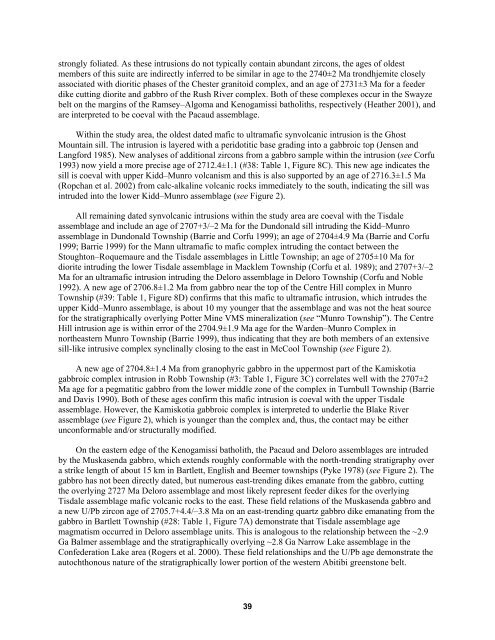Overview of Results from the Greenstone ... - Geology Ontario
Overview of Results from the Greenstone ... - Geology Ontario
Overview of Results from the Greenstone ... - Geology Ontario
Create successful ePaper yourself
Turn your PDF publications into a flip-book with our unique Google optimized e-Paper software.
strongly foliated. As <strong>the</strong>se intrusions do not typically contain abundant zircons, <strong>the</strong> ages <strong>of</strong> oldest<br />
members <strong>of</strong> this suite are indirectly inferred to be similar in age to <strong>the</strong> 2740±2 Ma trondhjemite closely<br />
associated with dioritic phases <strong>of</strong> <strong>the</strong> Chester granitoid complex, and an age <strong>of</strong> 2731±3 Ma for a feeder<br />
dike cutting diorite and gabbro <strong>of</strong> <strong>the</strong> Rush River complex. Both <strong>of</strong> <strong>the</strong>se complexes occur in <strong>the</strong> Swayze<br />
belt on <strong>the</strong> margins <strong>of</strong> <strong>the</strong> Ramsey–Algoma and Kenogamissi batholiths, respectively (Hea<strong>the</strong>r 2001), and<br />
are interpreted to be coeval with <strong>the</strong> Pacaud assemblage.<br />
Within <strong>the</strong> study area, <strong>the</strong> oldest dated mafic to ultramafic synvolcanic intrusion is <strong>the</strong> Ghost<br />
Mountain sill. The intrusion is layered with a peridotitic base grading into a gabbroic top (Jensen and<br />
Langford 1985). New analyses <strong>of</strong> additional zircons <strong>from</strong> a gabbro sample within <strong>the</strong> intrusion (see Corfu<br />
1993) now yield a more precise age <strong>of</strong> 2712.4±1.1 (#38: Table 1, Figure 8C). This new age indicates <strong>the</strong><br />
sill is coeval with upper Kidd–Munro volcanism and this is also supported by an age <strong>of</strong> 2716.3±1.5 Ma<br />
(Ropchan et al. 2002) <strong>from</strong> calc-alkaline volcanic rocks immediately to <strong>the</strong> south, indicating <strong>the</strong> sill was<br />
intruded into <strong>the</strong> lower Kidd–Munro assemblage (see Figure 2).<br />
All remaining dated synvolcanic intrusions within <strong>the</strong> study area are coeval with <strong>the</strong> Tisdale<br />
assemblage and include an age <strong>of</strong> 2707+3/–2 Ma for <strong>the</strong> Dundonald sill intruding <strong>the</strong> Kidd–Munro<br />
assemblage in Dundonald Township (Barrie and Corfu 1999); an age <strong>of</strong> 2704±4.9 Ma (Barrie and Corfu<br />
1999; Barrie 1999) for <strong>the</strong> Mann ultramafic to mafic complex intruding <strong>the</strong> contact between <strong>the</strong><br />
Stoughton–Roquemaure and <strong>the</strong> Tisdale assemblages in Little Township; an age <strong>of</strong> 2705±10 Ma for<br />
diorite intruding <strong>the</strong> lower Tisdale assemblage in Macklem Township (Corfu et al. 1989); and 2707+3/–2<br />
Ma for an ultramafic intrusion intruding <strong>the</strong> Deloro assemblage in Deloro Township (Corfu and Noble<br />
1992). A new age <strong>of</strong> 2706.8±1.2 Ma <strong>from</strong> gabbro near <strong>the</strong> top <strong>of</strong> <strong>the</strong> Centre Hill complex in Munro<br />
Township (#39: Table 1, Figure 8D) confirms that this mafic to ultramafic intrusion, which intrudes <strong>the</strong><br />
upper Kidd–Munro assemblage, is about 10 my younger that <strong>the</strong> assemblage and was not <strong>the</strong> heat source<br />
for <strong>the</strong> stratigraphically overlying Potter Mine VMS mineralization (see “Munro Township”). The Centre<br />
Hill intrusion age is within error <strong>of</strong> <strong>the</strong> 2704.9±1.9 Ma age for <strong>the</strong> Warden–Munro Complex in<br />
nor<strong>the</strong>astern Munro Township (Barrie 1999), thus indicating that <strong>the</strong>y are both members <strong>of</strong> an extensive<br />
sill-like intrusive complex synclinally closing to <strong>the</strong> east in McCool Township (see Figure 2).<br />
A new age <strong>of</strong> 2704.8±1.4 Ma <strong>from</strong> granophyric gabbro in <strong>the</strong> uppermost part <strong>of</strong> <strong>the</strong> Kamiskotia<br />
gabbroic complex intrusion in Robb Township (#3: Table 1, Figure 3C) correlates well with <strong>the</strong> 2707±2<br />
Ma age for a pegmatitic gabbro <strong>from</strong> <strong>the</strong> lower middle zone <strong>of</strong> <strong>the</strong> complex in Turnbull Township (Barrie<br />
and Davis 1990). Both <strong>of</strong> <strong>the</strong>se ages confirm this mafic intrusion is coeval with <strong>the</strong> upper Tisdale<br />
assemblage. However, <strong>the</strong> Kamiskotia gabbroic complex is interpreted to underlie <strong>the</strong> Blake River<br />
assemblage (see Figure 2), which is younger than <strong>the</strong> complex and, thus, <strong>the</strong> contact may be ei<strong>the</strong>r<br />
unconformable and/or structurally modified.<br />
On <strong>the</strong> eastern edge <strong>of</strong> <strong>the</strong> Kenogamissi batholith, <strong>the</strong> Pacaud and Deloro assemblages are intruded<br />
by <strong>the</strong> Muskasenda gabbro, which extends roughly conformable with <strong>the</strong> north-trending stratigraphy over<br />
a strike length <strong>of</strong> about 15 km in Bartlett, English and Beemer townships (Pyke 1978) (see Figure 2). The<br />
gabbro has not been directly dated, but numerous east-trending dikes emanate <strong>from</strong> <strong>the</strong> gabbro, cutting<br />
<strong>the</strong> overlying 2727 Ma Deloro assemblage and most likely represent feeder dikes for <strong>the</strong> overlying<br />
Tisdale assemblage mafic volcanic rocks to <strong>the</strong> east. These field relations <strong>of</strong> <strong>the</strong> Muskasenda gabbro and<br />
a new U/Pb zircon age <strong>of</strong> 2705.7+4.4/–3.8 Ma on an east-trending quartz gabbro dike emanating <strong>from</strong> <strong>the</strong><br />
gabbro in Bartlett Township (#28: Table 1, Figure 7A) demonstrate that Tisdale assemblage age<br />
magmatism occurred in Deloro assemblage units. This is analogous to <strong>the</strong> relationship between <strong>the</strong> ~2.9<br />
Ga Balmer assemblage and <strong>the</strong> stratigraphically overlying ~2.8 Ga Narrow Lake assemblage in <strong>the</strong><br />
Confederation Lake area (Rogers et al. 2000). These field relationships and <strong>the</strong> U/Pb age demonstrate <strong>the</strong><br />
autochthonous nature <strong>of</strong> <strong>the</strong> stratigraphically lower portion <strong>of</strong> <strong>the</strong> western Abitibi greenstone belt.<br />
39

















